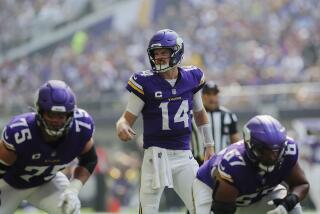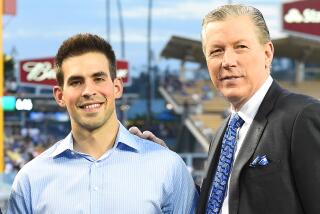PRO FOOTBALL : Cooke Is Big Winner in This ‘Skins Game
- Share via
WASHINGTON — When Jack Kent Cooke sold out in Los Angeles and began a new life here in 1979, he had about $50 million. In a dozen years, he has turned it into more than $1 billion.
But what does Cooke know about football?
More than people think, statisticians say. They rank him in the same class with two football specialists who have spent their adult lives in the game, Al Davis and Don Shula.
In Cooke’s 17 years as owner of the Washington Redskins, his team’s won-lost performance has been the NFC’s best, according to NFL statistical bureau chief Seymour Siwoff. The numbers:
--The Redskin record since 1974, Cooke’s first year in charge, is 167-94.
--Under Davis during that period, the Raiders are an NFL-best 169-92.
--The Miami Dolphins, as coached by Shula during that span, are 166-94-1.
“We’ve made stability a heritage,” Cooke said, accounting for his mastery of a game he never played as a youth in Canada. “The trick is to hire winners in the first place. The (Redskins) hardly ever lose an employee.”
One exception: Bobby Beathard. The general manager of the San Diego Chargers was Cooke’s general manager in 1978-89.
D.C. Super Bowl? If the Buffalo Bills own Buffalo, and the Denver Broncos own Colorado, the Redskins still appear to be everybody’s team in Washington.
Very little that happens on Capitol Hill, or elsewhere in the district, seems bigger to Washington people than a Redskin game, and that has been generally true for at least two decades.
That is why it is surprising that after three years of trying, the Redskins have been unable to interest the city in the new arena it needs to replace decaying RFK Stadium, where the capacity, 55,000, isn’t much larger than the waiting list for Redskin season tickets.
The new stadium would be privately financed, and Cooke, who built the Forum in Inglewood, has earmarked more than $100 million for the project. But he needs a place to put it.
Although the obvious site is an RFK parking lot, federal and district administrators can’t agree on how to proceed.
“It will be donated to the (district) after a period of time,” Cooke promised. “The capacity, 78,600, will be big enough for a Super Bowl. But that’s when and if.”
Trey blocking: During Joe Gibbs’ 10 years as coach of the Redskins, their two favorite running plays, which look alike at the snap, have been an off-tackle power play and the counter trey.
“They run them 50 times a game from every formation in the book,” said former NFL Coach Sid Gillman, who designed the counter trey many years ago.
So what is it?
“The counter trey has two (components),” Gillman said:
--Counter identifies the action of the running back. On such plays, he takes a handoff and fakes a run in one direction before heading in the opposite direction.
--Trey identifies a double-team blocking pattern.
“We have ace, deuce and trey blocking,” Gillman said. “On a typical trey block, the left guard and tackle pull out of the line and move to their right, ahead of the running back.”
That’s the kind of thing that has made Gibbs the most successful active coach of the last 10 years--although he doesn’t win them all.
Instant defense: For nearly a half in Buffalo Sunday, the Chicago Bears showed the NFL how to stop the Bills’ no-huddle offense.
As soon as the ball was whistled dead, ending a Buffalo offensive play, the Bears hurried in their situation specialists for the next play.
Vince Tobin, Mike Ditka’s defensive coordinator, didn’t wait for the Buffalo offense to make personnel commitments. He simply made instant adjustments--based on down and distance.
Then in the last two minutes of the half, Chicago, leading 6-0, changed into prevent defenses, and the Bills took off.
Forty yards later, in the midst of an 85-yard Buffalo touchdown drive, the Bears sent William Perry and most of their other basic defenders back into the game, but by then it was too late. The no-huddle Bills, once rolling, rolled on to win, 35-20.
Nevertheless, in the first 28 minutes, they had made only two first downs, and that is what the NFL will remember.
San Diego for L.A.: Against the San Diego Chargers Sunday, the Raiders won’t make it two Coliseum sellouts in a row, but they will have the support of more out-of-town friends than they had when the San Francisco 49ers were here.
Of the 30 Raider booster clubs in the world, three are in San Diego--and one of them is the largest of the 30.
The early 49er sellout surprised the Raider organization.
“The plans for (the new) Coliseum were announced during the week ahead of the game,” club executive Al LoCasale said. “That gave us more media attention than usual, and I think that put us over.”
The Jets are coming: For almost the first time since their Joe Namath days, the New York Jets are looking like a title contender.
Before upsetting Miami Sunday, they could have swept Buffalo and Chicago on successive weekends, when, in close games, they lost in strange ways both times.
“It’s harder than it looks to win that kind,” Jet General Manager Dick Steinberg said. “A winning team like (Buffalo) has a knack for finding a way to do it. Teams coming up, like us, have to learn how to do it.”
The Bears found a couple of ways Sept. 23:
--With two minutes to play, New York halfback Blair Thomas fumbled when stripped on first down. Shouldn’t the Jets have been using the kneel-down formation to run out the clock?
Said Jet Coach Bruce Coslet: “There was too much time left. We either had to run once or plan on punting on fourth down, and more things can go wrong for you on a punt (than a run).”
--Needing a chip-shot field goal in overtime, the Jets, kicking from the Chicago 18, blew it on first down. Shouldn’t they have run the ball once to get it into better field-goal position?
“It was makeable,” said Steinberg. “And if it’s makeable, kick it--the sooner the better.”
Said Coslet: “You chance a fumble, a holding penalty, and a lot of other bad things on (any unnecessary) run.”
Quote Department:
Keith Jackson, Philadelphia tight end--and buddy of injured quarterback Randall Cunningham--on Jim McMahon, who was Cunningham’s replacement until McMahon suffered a knee injury Monday night: “He’s a much nicer guy than I thought. He’s not the maniac portrayed in the media. I enjoy him.”
Bud Carson, Philadelphia defensive coordinator, on Eagle defensive end Clyde Simmons: “He’s a great pass rusher. I don’t think anyone knows about him, but he’s the best young pass rusher I’ve seen.”
More to Read
Go beyond the scoreboard
Get the latest on L.A.'s teams in the daily Sports Report newsletter.
You may occasionally receive promotional content from the Los Angeles Times.










